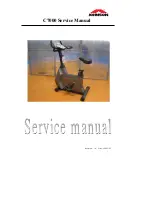
GB
O w n e r ’ s m a n u a l
•
P L A T I N U M P R O
23
Heart Rate Training
A word about Heart Rate:
The old motto, “no pain, no gain”, is a
myth that has been overpowered by the
benefits of exercising
comfortably. A great deal of this success
has been
promoted by the use of heart rate
monitors. With the proper use of a heart
rate monitor, many people find that their
usual choice of exercise intensity was
either too high or too low and exercise is
much more enjoyable by
maintaining their heart rate in the desired
benefit range.
To determine the benefit range in
which you wish to train, you must first
determine your Maximum Heart Rate.
This can be accomplished by using the
following formula: 220 minus your age.
This will give you the Maximum heart
rate (MHR) for someone of your age. To
determine the effective heart rate range
for specific goals you simply calculate
a percentage your MHR. Your Heart
rate training zone is 50% to 90% of your
maximum heart rate. 60% of your MHR
is the zone that burns fat while 70% is
for strengthening the cardio vascular
system. This 60% to 70% is the zone to
stay in for maximum benefit.
For someone who is 40 years old their
target heart rate zone is calculated:
220 – 40 = 180 (maximum heart rate)
180 x .6 = 108 beats per minute (60% of
maximum)
180 X .7 = 126 beats per minute (70% of
maximum)
So for a 40 year old the training zone
would be 108 to 126 beats per minute.
How to wear your wireless chest
strap transmitter:
• Attach the transmitter to the elastic
strap using the locking parts.
• Adjust the strap as tightly as possible
as long as the strap is not too tight to
remain comfortable.
• Position the transmitter with the logo
centred in the middle of your body
facing away from your chest (some
people must position the transmitter
slightly left of centre). Attach the final
end of the elastic strap by inserting
the round end and, using the locking
parts, secure the transmitter and
strap around your chest.
• Position the transmitter immediately
below the pectoral muscles.
• Sweat is the best conductor to
measure very minute heart beat
electrical signals. However, plain
water can also be used to pre-wet
the electrodes (2 black square areas
on the reverse side of the belt and
either side of transmitter). It’s also
recommended that you wear the
transmitter strap a few minutes
before your work out. Some users,
because of body chemistry, have
a more difficult time in achieving
a strong, steady signal at the
beginning. After “warming up”, this
problem lessens. As noted, wearing
clothing over the transmitter/strap
doesn’t affect performance.
• Your workout must be within range -
distance between transmitter/receiver
- to achieve a strong steady signal.
The length of range may vary some
what but generally stay close enough
to the console to maintain good,
strong, reliable readings. Wearing
the transmitter immediately against
Summary of Contents for Platinum Pro
Page 2: ......
Page 105: ...GB O w n e r s m a n u a l P L A T I N U M P R O 105 Exploded view ...
Page 106: ...106 O w n e r s m a n u a l P L A T I N U M P R O Notes ...
Page 107: ......
















































